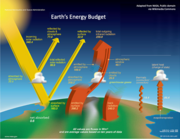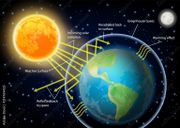BaCCC/Module 1/Lesson 2/Part 2
What causes climate change? (Natural and human factors)
In the previous lesson, you learnt that the Earth’s climate is driven by an energy input–output system, which originates from the sun. To understand the causes of climate change, you need to first understand the energy budget.
What is the Earth’s energy budget?
The balance between the incoming and outgoing energy is known as Earth’s “energy budget,” which is determined by the amount of sunlight that shines on the Earth (insolation) and how the characteristics of the Earth’s surface and atmosphere act on this energy, namely:
- The Earth’s surface (mainly oceans, but also forests and other dark-coloured landforms) absorbs about half of the incoming solar energy.
- The atmosphere absorbs about 23 per cent.
- The rest is reflected back into space (due to the albedo, or reflectivity, of snow, ice and desert sands)
- Some of that heat energy is then re-radiated back to the surface of the planet by greenhouse gases, which puts even more energy into the climate system.
The energy budget of the planet plays a key role in determining its climate. The Earth’s temperature can remain mostly stable as long as the energy budget is in balance, with no general rise or fall in the average temperature.
You can adjust the playback speed and/or turn on subtitles/captions.
If you have trouble accessing the video, a summary is available below.
H5P Object Parameters
The H5P parameters below will be replaced by the actual H5P object when it's rendered on the WordPress site to which it's been snapshotted.
(Note: A 70ºF increase between night and day in the Sahara is a nearly 40ºC increase. A 10ºF difference in the Amazon rainforest is only 5.5ºC. The Earth’s surface temperature is 58ºF or 14.5ºC. With no greenhouse gases in the atmosphere, the temperature would be about 0ºF or minus 18ºC. The surface temperature on Venus is 872ºF or 484ºC.)
From Lesson 2.1 and the videos you have watched so far, you have learnt that the three factors that affect the Earth’s energy budget are
- solar input or the total incoming solar energy (insolation), which mostly depends on the distance from the sun, the angle of the planet’s axis and solar activity
- the amount of albedo reflecting solar rays from the Earth back into space
- chemical composition of the atmosphere
Study the diagram below that illustrates the Earth’s energy budget.
The diagram is rather complex with all those numbers (of watts of solar energy per square metre), but it gives a good sense of the interplay between different kinds and amounts of energy that enter and leave the Earth system:
- “radiative components” (light and heat)
- other components of the budget
- conduction
- convection
- condensation
which also transport heat from the Earth’s surface
What is the greenhouse effect?
The greenhouse effect is a natural process that takes place when specific gases in the lower atmosphere trap the solar heat that keeps the Earth warm. The name “greenhouse gas” describes how these gases function similarly to greenhouse glass walls.
The greenhouse effect helps to maintain a specific temperature level on the Earth’s surface, making it habitable for living beings. While we appreciate that greenhouse gases play a vital role in keeping the Earth’s temperature at a level that supports life, the issue we currently confront is that of an “enhanced greenhouse effect.”
Study the diagram below that illustrates the greenhouse effect.
What is the enhanced greenhouse effect?
The enhanced greenhouse effect is where additional greenhouse gases in the lower atmosphere absorb and trap too much of the sun’s energy (too much, at least, for the civilisation we have built based on agriculture, and possibly for our survival as a species). This results in the surface temperature rising – a warming effect commonly known as “global warming.” And nowadays, we are constantly spewing more and more greenhouse gases into the atmosphere causing a build-up, which creates extra energy in the climate system, leading to more – and/or more powerful – cyclones, typhoons, hurricanes, tornadoes, rain bombs, rainstorms, hailstorms, lightning storms, etc.
You may wonder where these extra greenhouse gases are coming from.
There is clear evidence pointing to human actions being the main cause of increasing concentrations of greenhouse gases in the atmosphere. Scientific research has shown, without a doubt, that over the past 150 years since the Industrial Revolution, greenhouse gases have been rapidly increasing in the atmosphere.
The table that follows shows the main greenhouse gases that concentrate in the lower atmosphere, their sources, their lifetime in the atmosphere and their equivalency to carbon dioxide.
The main greenhouse gases| Main greenhouse gases | Their main sources | Lifetime in atmosphere |
|---|---|---|
| Carbon dioxide – (CO2) | Fossil fuel combustion, deforestation and cement production | 20−200 years (80%)
1,000 years (20%) |
| Methane – (CH4)
80 times more potent than (CO2) over its lifetime |
Fossil fuel production, agriculture (livestock and rice fields) and landfills | 12 years, then breaks down into (CO2), water and ozone |
| Nitrous oxide – (N2O)
280 times more potent |
Fertilisers, fossil fuel and biomass combustion, sewage and industrial processes | Up to 120 years, then disintegrates |
| Water vapour – H2O) | Oceans, lakes and reservoirs | Does not accumulate |
Synthetic (man-made) industrial gases such as
460 to 23,500 times more potent than (CO2) |
HFC – refrigeration and air conditioning CFCs – banned (Montreal Protocol), new sources might be illegal (SF6) – electrical energy generation |
HFCs: 15−29 years CFCs: 52−640 years (SF6): 3,200 years |
The term “anthropogenic” refers to human activities – intentional or unintentional – that affect the environment. While we agree that the greenhouse effect is a natural phenomenon, the extra gases produced by human activities are making it stronger. In other words, we are now adding to these gases faster than oceans and plants can absorb them, and so, the greenhouse effect is being “enhanced” by humans. The following example will help you understand the concept of the “enhanced greenhouse effect.”
| Imagine having a sizable greenhouse filled with flourishing, healthy plants, and having one of your employees prepare his lunch in there using firewood. As a result, a great deal of smoke is emitted, and the temperature rises significantly. You will surely feel angry when you find out the truth. This is because he has changed the greenhouse’s environment in a way that would cause plants to perish. He has increased or added additional heat and gases, which might harm or destroy the plants. |
| Place | Activity | Type(s) of greenhouse gas released |
|---|---|---|
| 1. Mr X’s home | (SF6) is released from charcoal that Mr X uses for cooking | Carbon dioxide (SF6) |
| My home | ||
| My neighbours | ||
| School | ||
| Hospital or clinic | ||
| Shopping centre | ||
| Garage | ||
| Busy road junction or bust station | ||
| Farm or garden | ||
| Dumping site | ||
| Industrial factory or mine |
2. Prepare a slide presentation to teach your community about the causes of greenhouse gas and their sources in your village, town or city. First, rehearse how you would present this to the public. If you have gained confidence, do a presentation for a few people and ask them to provide you with some feedback. (If you feel nervous about doing this, remember that climate champions feel the fear and do it anyway, for the sake of all living beings on this beautiful Earth.)
3. In your learning journal, write a brief review of your presentation, what went well and how you want to improve on it.
What are the results of the enhanced greenhouse effect?
One of the results of an enhanced greenhouse effect is an increase in air and ocean temperatures. The following experiment will demonstrate this.
| Feedback |
|---|
| It is important to take note that in both experiments, carbon dioxide was produced when adding baking soda to either vinegar or water. Both containers with carbon dioxide recorded a higher temperature. From this experiment, you learnt that added carbon dioxide can increase the temperature of the air, as demonstrated in plastic bag A, and can also increase water temperature, as demonstrated in bottle A. We can, therefore, conclude that extra greenhouse (“heat-trapping”) gases, such as carbon dioxide, result in increased atmospheric and ocean temperatures. We now need to ask ourselves, since humans are still adding more carbon dioxide and other greenhouse gases to the atmosphere, what happens when we continue to add more carbon dioxide and other greenhouse gases? |
In the videos that you have watched so far, mention is made of how enhanced greenhouse gases increase atmospheric temperatures, causing what is called global warming. We will learn more about this in the next part of the lesson.



